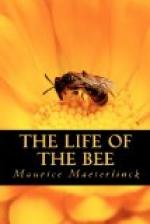Do obstacles offer no barrier to their sight; do they guide themselves by certain indications and landmarks; or do they possess that peculiar, imperfectly understood sense that we ascribe to the swallows and pigeons, for instance, and term the “sense of direction”? The experiments of J. H. Fabre, of Lubbock, and, above all, of Romanes (Nature, 29 Oct. 1886) seem to establish that it is not this strange instinct that guides them. I have, on the other hand, more than once noticed that they appear to pay no attention to the colour or form of the hive. They are attracted rather by the ordinary appearance of the platform on which their home reposes, by the position of the entrance, and of the alighting-board. But this even is merely subsidiary; were the front of the hive to be altered from top to bottom, during the workers’ absence, they would still unhesitatingly direct their course to it from out the far depths of the horizon; and only when confronted by the unrecognisable threshold would they seern for one instant to pause. Such experiments as lie in our power point rather to their guiding themselves by an extraordinarily minute and precise appreciation of landmarks. It is not the hive that they seem to remember, but its position, calculated to the minutest fraction, in its relation to neighbouring objects. And so marvellous is this appreciation, so mathematically certain, so profoundly inscribed in their memory, that if, after five months’ hibernation in some obscure cellar, the hive, when replaced on the platform, should be set a little to right or to left of its former position, all the workers, on their return from the earliest flowers, will infallibly steer their direct and unwavering course to the precise spot that it filled the previous year; and only after some hesitation and groping will they discover the door which stands not now where it once had stood. It is as though space had preciously preserved, the whole winter through, the indelible track of their flight: as though the print of their tiny, laborious footsteps, still lay graven in the sky.
If the hive be displaced, therefore, many bees will lose their way; except in the case of their having been carried far from their former home, and finding the country completely transformed that they had grown to know perfectly within a radius of two or three miles; for then, if care be taken to warn them, by means of a little gangway connecting with the alighting-board, at the entrance to the hive, that some change has occurred, they will at once proceed to seek new bearings and create fresh landmarks.
[67]




